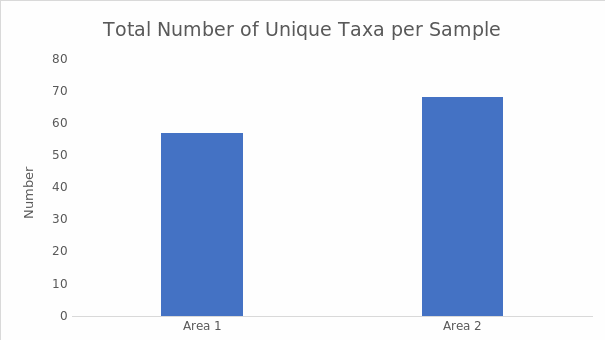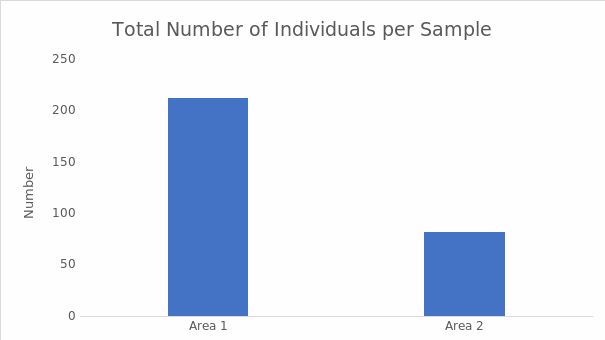Introduction
Biodiversity refers to the variety of life, the hereditary information contained in organisms, and the ecological units where these organisms live. Biodiversity can be studied in various ways, including species abundance, species richness, and species diversity. Species abundance refers to the total number of members of a given species in a defined area. In contrast, species richness denotes the number of species found in a predefined location without considering the number of individuals present per species. Such an approach provides an overview of the biodiversity of assorted communities, for instance, rainforests. Conversely, species diversity considers two key factors in its determination. These are the number of species as well as their relative abundance (Hillebrand et al. 2018). These measures of diversity can be computed using different indices. One such index is the Simpson’s Index of Diversity, which considers the total number of species and the relative abundance of each species. Diversity, which is denoted by D, increases as the number of species and their relative abundance increase. This value ranges between 0 and 1 where 0 shows very low diversity while 1 indicates high diversity (Santini et al. 2017).
The ecosystem consists of many organisms that can be classified as vertebrates or invertebrates. The latter group consists of cold-blooded animals without a backbone. Examples include members of the phyla Arthropoda (insects and arachnids), Annelida (worms), and Mollusca (snails and slugs). These organisms are considered pests that should be regulated because their societal or economic importance is not obvious. Therefore, there are no policies to conserve them. However, from an ecological and evolutionary perspective, these organisms are not pests and have a right to exist due to their position in the evolutionary tree and ecological importance (Hillebrand et al. 2018). The ecological roles of invertebrates include the creation and aeration of the soil, pollination of flowers, and food for other economically important organisms (Hallmann et al. 2017). Man-made uses for invertebrates include the production of raw materials for industrial manufacturing processes (wax, honey, or silk) and specimens for scientific investigations. Therefore, maintaining diversity in an ecosystem is crucial to avoid losing species. Human activities are the key causes of ecological disturbances, which interfere with the biodiversity of organisms. The purpose of this paper is to investigate the effect of habitat disturbance on invertebrate diversity. The study area is next to the Crommelin Field Station, at Pearl Beach on the New South Wales Central Coast. This area had originally been a pig farm that was later converted to a forest. It was hypothesized that disturbances to the habitat would lead to a reduction in the biodiversity of invertebrates as measured by the Simpson’s Index of Diversity.
Results
Habitat disturbance reduced the invertebrate diversity of areas 1 and 2. Simpson’s Index of Diversity (D) was 0.625 for area 1 (disturbed) and 0.939 for area 2 (undisturbed). There was no significant difference between the number of unique taxa in area 1 and area 2 (t= -1.287, df= 13, p= 0.219). However, area 1 had significantly more individuals per sample than area 2 (t= 2.348, df= 17, p= 0.031). Figures 1 and 2 indicate the relative distributions of the unique taxa and total individuals, respectively. Tables 1 and 2 summarize the data that were collected and statistical calculations.
Table 1: Total number of unique taxa per sample.
Table 2: Total number of individuals per sample.

Area 1 had significantly more unique taxa than area 2 (t= -1.287, df= 13, p= 0.219; Figure 1).

Area 1 had significantly more individuals than area 2 (t= 2.348, df= 17, p= 0.031; Figure 2).
Discussion
The purpose of the study was to investigate the effect of habitat disturbance on invertebrate diversity of two areas. The mean species richness was higher in the undisturbed area than the disturbed area. However, the mean abundance was lower for the undisturbed habitat than the disturbed area. Simpson’s Diversity Index (D) was higher for the undisturbed habitat (area 2) than the disturbed region (area 1). These outcomes supported the hypothesis that ecological disturbance would lead to a reduction in invertebrate diversity.
These results are similar to those reported by Hallman et al. (2017), which showed a decline in invertebrate diversity and abundance over 21 years. These observations are linked to factors such as loss of habitat, climate change and fragmentation. Changes in land use affect the richness of plant species, which in turn influence the variety of invertebrate species that can thrive in specific ecological niches (Santini et al. 2017).
It was noted that the disturbed area (1) had a higher invertebrate abundance (number of total individuals) than the undisturbed area (2), yet its diversity index was lower than for area 2. However, the total number of unique taxa per sample was lower for area 1 than area 2. This observation aligns with the assertion that reductions in the number of individual species or taxa are not accurate reflections of the overall state of local entomofauna (Hallman et al. 2017). In a separate study conducted by Hillebrand et al. (2018), the key observation was that species richness had no direct relationship with biodiversity and was not a reliable metric for changes in biodiversity. Hillebrand et al. (2018) also report that negative changes in environmental quality can cause short-lived upsurges in species richness if the influence of immigration and extinction are negligible.
The methodological approach used in the study had a few strengths and weaknesses. One of the major strengths was the inclusion of 16 replicates per area, which enabled the sampling of a bigger area. Consequently, the data could be considered a true representation of species abundance and richness for the two study areas.
The sampling approach also contributed to the weaknesses of the study. For example, it was noted that most sampling areas (replicates) did not have any representative invertebrate species. This phenomenon could be linked to low species abundance and diversity in the study areas. Nonetheless, it could be as a result of sampling flaws such as failing to consider the influence of topology in species distribution (Hallman et al. 2017). An alternative approach that could be used to counter this shortcoming is measuring the total invertebrate biomass. The distribution of certain species also fluctuates with variations in seasons (Uieda et al. 2016). Future studies could consider sampling the disturbed and undisturbed areas during different seasons to compare the species richness and abundance. Such an approach would provide a more accurate depiction of the impact of disturbance on invertebrate diversity.
Conclusion
Environmental disturbances interfere with invertebrate species richness and species abundance, thereby lowering the overall diversity. Time-based trends in species richness and abundance provide useful data to evaluate diversity. However, species richness alone may not capture pertinent changes in biodiversity in shifting ecologies. Therefore, biodiversity surveillance programmes should consider looking beyond species richness and abundance in the assessment of changes in biodiversity to capture more meaningful data.
Reference List
- Hallmann, CA, Sorg, M, Jongejans, E, Siepel, H, Hofland, N, Schwan, H, Stenmans, W, Müller, A, Sumser, H, Hörren, T & Goulson, D (2017) More than 75 percent decline over 27 years in total flying insect biomass in protected areas. PloS One. 12: 1-21.
- Hillebrand, H, Blasius, B, Borer, ET, Chase, JM, Downing, JA, Eriksson, BK, Filstrup, CT, Harpole, WS, Hodapp, D, Larsen, S & Lewandowska, AM (2018) Biodiversity change is uncoupled from species richness trends: Consequences for conservation and monitoring. Journal of Applied Ecology, 55: 169-184.
- Santini, L., Belmaker, J., Costello, M.J., Pereira, H.M., Rossberg, AG, Schipper, AM, Ceaușu, S, Dornelas, M, Hilbers, JP, Hortal, J & Huijbregts, MA (2017) Assessing the suitability of diversity metrics to detect biodiversity change. Biological Conservation, 213: 341-350.
- Uieda, VS, Iwai, MLB, Ono, ER, Melo, ALU, & Alves, MIB (2017) How seasonality and anthropogenic impacts can modulate the structure of aquatic benthic invertebrate assemblages. Community Ecology. 18: 47-55.